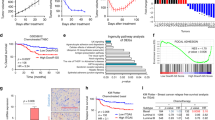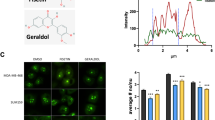Abstract
We have previously reported that daptomycin (DAP), a last resort antibiotic, binds to ribosomal protein S19 (RPS19) in humans and exhibits selective anti-cancer activity against MCF7 breast cancer cells. Here, we investigated the role of RPS19 in the anti-cancer effects of DAP and have found that DAP does not induce autophagy, apoptosis or cell viability but does reduce cell proliferation. Our results suggest that an extraribosomal function of RPS19 involves the regulation of vascular endothelial growth factor (VEGF) but not EGF, PDGF or FGF. Engagement of RPS19 by DAP was shown by CETSA and ITDRFCETSA assays, and knocking down of RPS19 with siRNA increased the potency of DAP in MCF7 cells. In addition, DAP suppressed the secretion of VEGF in cancer cells and thereby inhibited cell migration. Collectively, these data provide an outline of the underlying mechanism of how DAP exhibits anti-cancer activity and suggests that RPS19 could be a promising target for the development of new anticancer drugs.
This is a preview of subscription content, access via your institution
Access options
Subscribe to this journal
Receive 12 print issues and online access
$259.00 per year
only $21.58 per issue
Buy this article
- Purchase on Springer Link
- Instant access to full article PDF
Prices may be subject to local taxes which are calculated during checkout




Similar content being viewed by others
References
Debono M, Barnhart M, Carrell C, Hoffmann J, Occolowitz J, Abbott B, et al. A21978C, a complex of new acidic peptide antibiotics: isolation, chemistry, and mass spectral structure elucidation. J Antibiot (Tokyo). 1987;40:761–77.
Müller A, Wenzel M, Strahl H, Grein F, Saaki TN, Kohl B, et al. Daptomycin inhibits cell envelope synthesis by interfering with fluid membrane microdomains. Proc Natl Acad Sci USA. 2016;113:E7077–E86.
Corsello SM, Nagari RT, Spangler RD, Rossen J, Kocak M, Bryan JG, et al. Discovering the anticancer potential of non-oncology drugs by systematic viability profiling. Nat Cancer. 2020;1:235–48.
Gotsbacher MP, Cho S, Kwon HJ, Karuso P. Daptomycin, a last-resort antibiotic, binds ribosomal protein S19 in humans. Proteome Sci. 2016;15:1–15.
Libson S, Lippman M. A review of clinical aspects of breast cancer. Int Rev Psychiatry 2014;26:4–15.
Foulkes WD, Smith IE, Reis-Filho JS. Triple-negative breast cancer. N. Engl J Med. 2010;363:1938–48.
Bartucci M, Morelli C, Mauro L, Surmacz E. Differential insulin-like growth factor I receptor signaling and function in estrogen receptor (ER)-positive MCF-7 and ER-negative MDA-MB-231 breast cancer cells. Cancer Res. 2001;61:6747–54.
Fisher B, Costantino J, Redmond C, Poisson R, Bowman D, Couture J, et al. A randomized clinical trial evaluating tamoxifen in the treatment of patients with node-negative breast cancer who have estrogen-receptor–positive tumors. N. Engl J Med. 1989;320:479–84.
Shou J, Massarweh S, Osborne CK, Wakeling AE, Ali S, Weiss H, et al. Mechanisms of tamoxifen resistance: increased estrogen receptor-HER2/neu cross-talk in ER/HER2–positive breast cancer. J Natl Cancer Inst. 2004;96:926–35.
Bogin L, Degani H. Hormonal regulation of VEGF in orthotopic MCF7 human breast cancer. Cancer Res. 2002;62:1948–51.
Kim J, Kong J, Chang H, Kim H, Kim A. EGF induces epithelial-mesenchymal transition through phospho-Smad2/3-Snail signaling pathway in breast cancer cells. Oncotarget. 2016;7:85021.
Gotsbacher MP, Cho SM, Kim NH, Liu F, Kwon HJ, Karuso P. Reverse chemical proteomics identifies an unanticipated human target of the antimalarial artesunate. ACS Chem Biol. 2019;14:636–43.
Cho SM, Lee HK, Liu Q, Wang M-W, Kwon HJ. A guanidine-based synthetic compound suppresses angiogenesis via inhibition of acid ceramidase. ACS Chem Biol. 2018;14:11–9.
Albini A, Iwamoto Y, Kleinman H, Martin G, Aaronson S, Kozlowski J, et al. A rapid in vitro assay for quantitating the invasive potential of tumor cells. Cancer Res. 1987;47:3239–45.
Chang J, Jung HJ, Jeong SH, Kim HK, Han J, Kwon HJ. A mutation in the mitochondrial protein UQCRB promotes angiogenesis through the generation of mitochondrial reactive oxygen species. Biochem Biophys Res Commun. 2014;455:290–7.
Jafari R, Almqvist H, Axelsson H, Ignatushchenko M, Lundbäck T, Nordlund P, et al. The cellular thermal shift assay for evaluating drug target interactions in cells. Nat Protoc. 2014;9:2100.
Barleon B, Sozzani S, Zhou D, Weich HA, Mantovani A, Marme D. Migration of human monocytes in response to vascular endothelial growth factor (VEGF) is mediated via the VEGF receptor flt-1. Blood. 1996;87:3336–43.
Price JT, Tiganis T, Agarwal A, Djakiew D, Thompson EW. Epidermal growth factor promotes MDA-MB-231 breast cancer cell migration through a phosphatidylinositol 3′-kinase and phospholipase C-dependent mechanism. Cancer Res. 1999;59:5475–78.
Liang C-C, Park AY, Guan J-L. In vitro scratch assay: a convenient and inexpensive method for analysis of cell migration in vitro. Nat Protoc. 2007;2:329.
Silverman JA, Perlmutter NG, Shapiro HM. Correlation of daptomycin bactericidal activity and membrane depolarization in Staphylococcus aureus. Antimicrob Agents Chemother. 2003;47:2538–44.
Jung D, Rozek A, Okon M, Hancock RE. Structural transitions as determinants of the action of the calcium-dependent antibiotic daptomycin. Chem Biol 2004;11:949–57.
Patel S, Saw S. Daptomycin: StatPearls Publishing, Treasure Island (FL); 2020.
Lomenick B, Hao R, Jonai N, Chin RM, Aghajan M, Warburton S, et al. Target identification using drug affinity responsive target stability (DARTS). Proc Natl Acad Sci USA. 2009;106:21984–89.
Justus CR, Leffler N, Ruiz-Echevarria M, Yang LV. In vitro cell migration and invasion assays. J Vis Exp. 2014;88:e51046.
Ashburn TT, Thor KB. Drug repositioning: identifying and developing new uses for existing drugs. Nat Rev Drug Discov 2004;3:673–83.
Padhy B, Gupta Y. Drug repositioning: re-investigating existing drugs for new therapeutic indications. J Postgrad Med. 2011;57:153.
Cao X, Wang A, Jiao R, Wang C, Mao D, Yan L, et al. Surfactin induces apoptosis and G 2/M arrest in human breast cancer MCF-7 cells through cell cycle factor regulation. Cell Biochem Biophys. 2009;55:163–71.
Park SY, Kim J-H, Lee YJ, Lee SJ, Kim Y. Surfactin suppresses TPA-induced breast cancer cell invasion through the inhibition of MMP-9 expression. Int J Oncol. 2013;42:287–96.
Lai M-D, Xu J. Ribosomal proteins and colorectal cancer. Curr Genomics. 2007;8:43–49.
de las Heras-Rubio A, Perucho L, Paciucci R, Vilardell J, Lleonart ME. Ribosomal proteins as novel players in tumorigenesis. Cancer Metastasis Rev. 2014;33:115–41.
Xu X, Xiong X, Sun Y. The role of ribosomal proteins in the regulation of cell proliferation, tumorigenesis, and genomic integrity. Sci China Life Sci. 2016;59:656–72.
Molavi G, Samadi N, Hosseingholi EZ. The roles of moonlight ribosomal proteins in the development of human cancers. J Cell Physiol. 2019;234:8327–41.
Lindstroem MS. Emerging functions of ribosomal proteins in gene-specific transcription and translation. Biochem Biophys Res Commun. 2009;379:167–70.
Angelini M, Cannata S, Mercaldo V, Gibello L, Santoro C, Dianzani I, et al. Missense mutations associated with Diamond-Blackfan anemia affect the assembly of ribosomal protein S19 into the ribosome. Hum Mol Genet. 2007;16:1720–27.
Arbiv OA, Cuvelier G, Klaassen RJ, Fernandez CV, Robitaille N, Steele M, et al. Molecular analysis and genotype-phenotype correlation of Diamond-Blackfan anemia. Clin Genet. 2018;93:320–28.
Chiocchetti A, Gibello L, Carando A, Aspesi A, Secco P, Garelli E, et al. Interactions between RPS19, mutated in Diamond-Blackfan anemia, and the PIM-1 oncoprotein. Haematologica. 2005;90:1453–62.
Berse B, Brown LF, Van De Water L, Dvorak HF, Senger DR. Vascular permeability factor (vascular endothelial growth factor) gene is expressed differentially in normal tissues, macrophages, and tumors. Mol Biol Cell. 1992;3:211–20.
Monacci WT, Merrill MJ, Oldfield EH. Expression of vascular permeability factor/vascular endothelial growth factor in normal rat tissues. Am J Physiol Cell Physiol. 1993;264:C995–C1002.
Acknowledgements
This work was partly supported by grants from the National Research Foundation of Korea (MSIP; 2015K1A1A2028365, 2015M3A9C4076321), the Brain Korea 21Four Project in the Republic of Korea, and ICONS (Institute of Convergence Science), Yonsei University and the ARC discovery grant DP1301032.
Author information
Authors and Affiliations
Corresponding author
Ethics declarations
Conflict of interest
The authors declare no competing interests.
Additional information
Publisher’s note Springer Nature remains neutral with regard to jurisdictional claims in published maps and institutional affiliations.
Supplementary information
Rights and permissions
About this article
Cite this article
Cho, S.M., Lee, H.J., Karuso, P. et al. Daptomycin suppresses tumor migration and angiogenesis via binding to ribosomal protein S19 in humans. J Antibiot 74, 726–733 (2021). https://doi.org/10.1038/s41429-021-00446-x
Received:
Revised:
Accepted:
Published:
Issue Date:
DOI: https://doi.org/10.1038/s41429-021-00446-x



